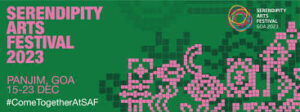 Goa is at its best in December. Of course. Well, a huge icing is the sprawling Serendipity Arts Festival (SAF), which adds so many delightful experiences. The upcoming sixth on ground edition of the festival has 150 events, 300+ artists, 10 curators, another 15 special curators lined up, across 12 venues. Add 15 commissioned works, one picturesque location and you get India’s most diverse, interdisciplinary festival. SAF, which has set benchmarks by blending performing, visual, culinary and performance arts and craft, has become a byword for showcasing not just the best in these spaces, but also empower their practitioners while taking forward these priceless heritages. The people behind this remarkable festival, Sunil Kant Munjal, chairman, Hero Group and founder patron of the Serendipity Arts and Smriti Rajgarhia, director of the festival, tell Suman Tarafdar about the highlights of this edition. Here are the excerpts from the conversation.
Goa is at its best in December. Of course. Well, a huge icing is the sprawling Serendipity Arts Festival (SAF), which adds so many delightful experiences. The upcoming sixth on ground edition of the festival has 150 events, 300+ artists, 10 curators, another 15 special curators lined up, across 12 venues. Add 15 commissioned works, one picturesque location and you get India’s most diverse, interdisciplinary festival. SAF, which has set benchmarks by blending performing, visual, culinary and performance arts and craft, has become a byword for showcasing not just the best in these spaces, but also empower their practitioners while taking forward these priceless heritages. The people behind this remarkable festival, Sunil Kant Munjal, chairman, Hero Group and founder patron of the Serendipity Arts and Smriti Rajgarhia, director of the festival, tell Suman Tarafdar about the highlights of this edition. Here are the excerpts from the conversation.
Suman Tarafdar – Congratulations on the 6th edition of the festival. What are the highlights of the upcoming edition?
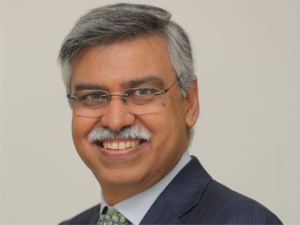
Sunil Kant Munjal, Founder Patron, Serendipity Arts Foundation
Sunil Kant Munjal (SKM) : Inclusivity and sustainability have always been at the heart of previous editions, and the 2023 festival is no different with independent and collaborative projects that highlight sustainability and inclusivity. Much like our previous editions, the festival will continue to have region-specific projects, workshops for people with special needs, and a dedicated segment with children’s programs. We are also pleased to continue giving South Asian artists a platform to amplify their voices and to create a community where young minds can engage, ideate, and co-create. Furthermore, this year we are delighted to be working with a large number of international collaborators and cultural institutions on projects across the arts.
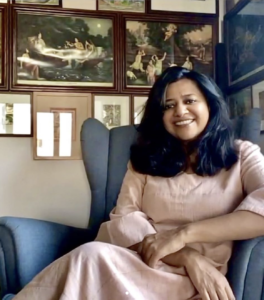
Smriti Rajgrahia, Director, Serendipity Arts Foundation & Festival
Smriti Rajgarhia (SR) : Our curatorial team of over a dozen top artists and practitioners across different art forms always tries to introduce fresh and unexplored perspectives. While it is difficult to handpick a few names from our dynamic programming, there are some interesting culinary workshops exploring local food and sustainable ways of eating. There is a focus on local produce, cultivating sustainability with permaculture gardening, and more. We have an installation Bamboo: A Way Of Life that explores how the material has been a central fabric of the existence and daily activities of several communities across the northeast. Another captivating installation work A Longing for Home/ Food Booth preserves cherished family recipes in an interactive manner. This innovative setup invites individuals to step into the phone booth and embark on a nostalgic culinary journey. River Raag is a unique sunset cruise featuring classical performances and so are our series of engaging talks. Our children’s programming is equally vibrant.
How is the festival implementing interdisciplinarity, especially as the arts and crafts in India have tended to function separately from each other? What advantages does interdisciplinarity bring to a multi-dimensional festival such as Serendipity?
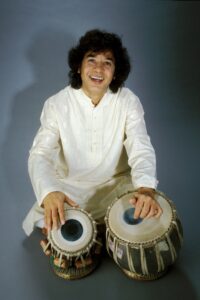
An Evening Of Serendipity With Zakir Hussain And Friends
SKM: Serendipity Arts Foundation started off as a platform to represent the broader spectrum of our multicultural diversities through Indian art forms that often don’t the due attention. We wanted to bring back the original idiom of Indian culture to the forefront, but we were clear that we didn’t want to go the traditional way of treating craft forms, or any of the art forms for that matter, in silos. We were firm that our festival has to foster a collaborative environment where artists, craftsmen, creators and innovators work closely together to blend traditional craftsmanship into contemporary idiom. This foundation of incorporating interdisciplinarity into a multi-dimensional festival has resulted in the promotion of cross-pollination of ideas and techniques. This fusion not only enriches the creative process but also leads to the production of interesting projects that reflect the synergy of different disciplines.
 SR: I also feel that interdisciplinarity encourages experimentation and innovation. How distinct crafts, performances, and arts come together while pushing the boundaries of traditional practices creates new artistic expressions. We also believe that a festival should enable community partnership and collaborative spirit to create a vibrant ecosystem of cultural exchange and varied expressions. Serendipity Arts Festival has been doing that year after year. Our curators bring in fresh perspectives and voices from their respective fields, they always find inventive ways to tell a story through activities that are engaging and meaningful. For instance, this year, there is a very interesting marriage between Kaavad and Mohiniyattam, where you will see a performance uniting two ancient traditions. A closer look at our thoughtfully curated programming will give you a glimpse into the magic an interdisciplinary festival can create on such a large scale.
SR: I also feel that interdisciplinarity encourages experimentation and innovation. How distinct crafts, performances, and arts come together while pushing the boundaries of traditional practices creates new artistic expressions. We also believe that a festival should enable community partnership and collaborative spirit to create a vibrant ecosystem of cultural exchange and varied expressions. Serendipity Arts Festival has been doing that year after year. Our curators bring in fresh perspectives and voices from their respective fields, they always find inventive ways to tell a story through activities that are engaging and meaningful. For instance, this year, there is a very interesting marriage between Kaavad and Mohiniyattam, where you will see a performance uniting two ancient traditions. A closer look at our thoughtfully curated programming will give you a glimpse into the magic an interdisciplinary festival can create on such a large scale.
How is the festival looking to engage more with the local residents? Are there local tie-ups with hotels, cultural institutions, tourism bodies etc that will channel audiences to the festival?
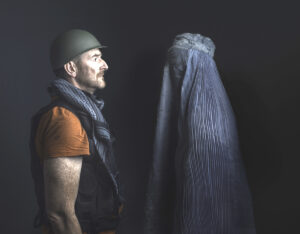
Henry-Naylor-in-Afghanistan is Not Funny
SR: We actively find ways to engage with local communities of Goa, its art, craft and amazing history through our programming to inform and engage locals, as well as, other attendees to experience Goa not just as a venue, but as a city with a cultural history. For instance, this year, we have several Goa-specific projects and activities. There is Postcards from Goa which is a promenade production that seeks to tell stories that contextualize the queer experiences in Goa, and retrofit them to locations in Panjim, along a scenic and culturally resonant walking trail. An interesting workshop Feni Deconstructed: A Sensory Experience will delve into the fascinating journey of the making of the local liquor from ripe cashew apples to the age-old bhatti distillation. A Goan singer-songwriter will be playing jazz, Blues and some native Goan folk in Joanne Fernandes And The Local Tribe. Another notable project is Goa Familia: Let The Sound Linger which is dedicated to encapsulating music and song as the quintessence of the Goan spirit.
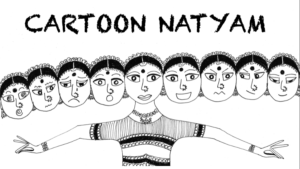
Cartoon Natyam by Veena Basavarajaiah
How is the festival looking at aiding sustainability in the arts?
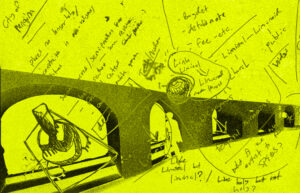
holy-flux-(CAN-ALSO-BE-LEAD)
SKM: There are many ways in which we attempt to tackle the very important question of sustainability through our actions and through spreading awareness. Our culinary arts curation this year, put together by Chef Thomas Zacharias and the Locavore Team is advocating “Doing Good Through Food”, looking at all the ways in which we consume and educate ourselves about food with a focus on the local and the sustainable – whether it is through “Zero Waste Cooking”, or “A Know Your Desi Vegetables” installation, or a variety of educational workshops and talks on topics such as solutions for human animal conflict, and climate-first futures with millets. We’re also covering subjects related to the environment though our exhibitions related to the craft exhibition – Bamboo: A Way of Life; and Blue Carbon and Time as a Mother which looks at the intersection of art and ecology. Additionally, we aim to be sustainable though our messaging and the materials we use, as much as we possibly can.
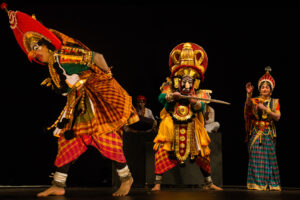
Bards-of-the-South
Pre-COVID, the festival was looking at editions of the festival in other cities. Is that still on the cards? If so, where else will the festival be seen?
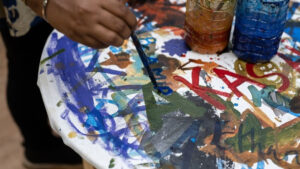 SKM: We continuously aspire to make the festival more inclusive, accessible, and sustainable, while finding ways to engage with local communities of Goa, its art, craft and amazing history. Our programming will continue to inform and engage, getting people to experience Goa not just as a venue, but as a city with a cultural history. We have tried, in recent years, to take specific aspects of the Serendipity Arts Festival to different cities so that people there also get a glimpse of our dynamic programming. We had a fantastic #BeyondSerendipity campaign this year, during which SAF commissioned projects travelled to cities like Puducherry, Kolkata and New Delhi. The responses to the plays and performances we presented in these cities were overwhelming. We plan to make this initiative an integral part of our yearly calendar and subsequently add a new set of cities with every chapter.
SKM: We continuously aspire to make the festival more inclusive, accessible, and sustainable, while finding ways to engage with local communities of Goa, its art, craft and amazing history. Our programming will continue to inform and engage, getting people to experience Goa not just as a venue, but as a city with a cultural history. We have tried, in recent years, to take specific aspects of the Serendipity Arts Festival to different cities so that people there also get a glimpse of our dynamic programming. We had a fantastic #BeyondSerendipity campaign this year, during which SAF commissioned projects travelled to cities like Puducherry, Kolkata and New Delhi. The responses to the plays and performances we presented in these cities were overwhelming. We plan to make this initiative an integral part of our yearly calendar and subsequently add a new set of cities with every chapter.
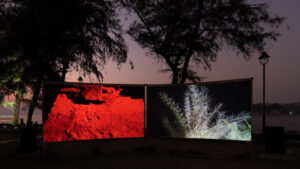 Any other facet of the festival that is important to note?
Any other facet of the festival that is important to note?
SKM: The beauty of our interdisciplinary festival is that it is a potpourri: you will always find something that piques your interest Almost anyone who has ever been to the festival comments that it is wonderfully creative, entertaining, informative and welcoming with its army of volunteers. Most visitors tend to become regular repeat visitors and find satisfaction in immersing themselves in multiple art forms at one place at one time including getting to attend workshops with senior artists and listen to academics and subject matter experts in the conferences and conclaves that take place as a part of the Serendipity Arts Festival.
